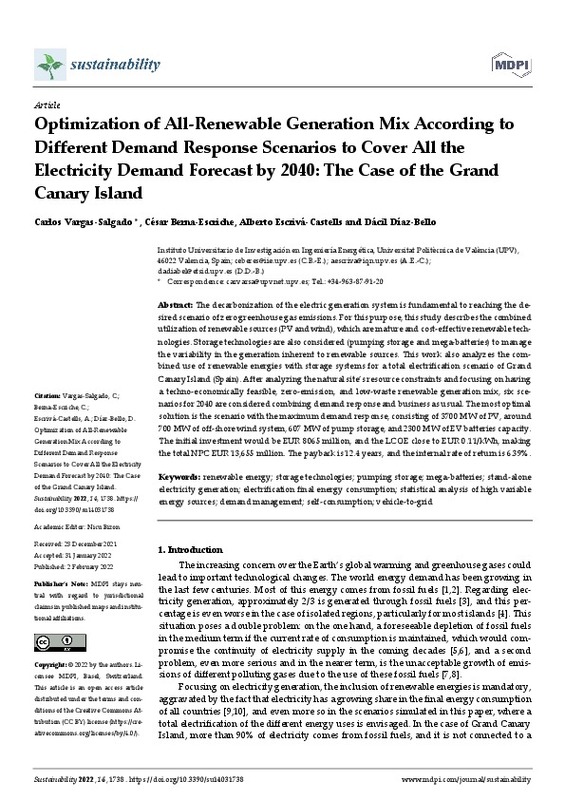JavaScript is disabled for your browser. Some features of this site may not work without it.
Buscar en RiuNet
Listar
Mi cuenta
Estadísticas
Ayuda RiuNet
Admin. UPV
Optimization of All-Renewable Generation Mix According to Different Demand Response Scenarios to Cover All the Electricity Demand Forecast by 2040: The Case of the Grand Canary Island
Mostrar el registro sencillo del ítem
Ficheros en el ítem
| dc.contributor.author | Vargas-Salgado, Carlos
|
es_ES |
| dc.contributor.author | Berna, C.
|
es_ES |
| dc.contributor.author | Escrivá, A.
|
es_ES |
| dc.contributor.author | Díaz-Bello, Dácil
|
es_ES |
| dc.date.accessioned | 2022-03-22T19:02:43Z | |
| dc.date.available | 2022-03-22T19:02:43Z | |
| dc.date.issued | 2022-02-02 | es_ES |
| dc.identifier.uri | http://hdl.handle.net/10251/181508 | |
| dc.description.abstract | [EN] The decarbonization of the electric generation system is fundamental to reaching the desired scenario of zero greenhouse gas emissions. For this purpose, this study describes the combined utilization of renewable sources (PV and wind), which are mature and cost-effective renewable technologies. Storage technologies are also considered (pumping storage and mega-batteries) to manage the variability in the generation inherent to renewable sources. This work also analyzes the combined use of renewable energies with storage systems for a total electrification scenario of Grand Canary Island (Spain). After analyzing the natural site¿s resource constraints and focusing on having a techno-economically feasible, zero-emission, and low-waste renewable generation mix, six scenarios for 2040 are considered combining demand response and business as usual. The most optimal solution is the scenario with the maximum demand response, consisting of 3700 MW of PV, around 700 MW of off-shore wind system, 607 MW of pump storage, and 2300 MW of EV batteries capacity. The initial investment would be EUR 8065 million, and the LCOE close to EUR 0.11/kWh, making the total NPC EUR 13,655 million. The payback is 12.4 years, and the internal rate of return is 6.39% | es_ES |
| dc.description.sponsorship | This study has been in part supported by the projects: "Design Of a Hybrid Renewable Microgrid System" and "Microred Inteligente Hibrida de Energias Renovables para Solucionar el Trilema Agua-Alimentacion-Energia en Una Comunidad Rural de Honduras" | es_ES |
| dc.language | Inglés | es_ES |
| dc.publisher | MDPI AG | es_ES |
| dc.relation.ispartof | Sustainability | es_ES |
| dc.rights | Reconocimiento (by) | es_ES |
| dc.subject | Renewable energy | es_ES |
| dc.subject | Storage technologies | es_ES |
| dc.subject | Pumping storage | es_ES |
| dc.subject | Mega-batteries | es_ES |
| dc.subject | Stand-alone electricity generation | es_ES |
| dc.subject | Electrification final energy consumption | es_ES |
| dc.subject | Statistical analysis of high variable energy sources | es_ES |
| dc.subject | Demand management | es_ES |
| dc.subject | Self-consumption | es_ES |
| dc.subject | Vehicle-to-grid | es_ES |
| dc.title | Optimization of All-Renewable Generation Mix According to Different Demand Response Scenarios to Cover All the Electricity Demand Forecast by 2040: The Case of the Grand Canary Island | es_ES |
| dc.type | Artículo | es_ES |
| dc.identifier.doi | 10.3390/su14031738 | es_ES |
| dc.rights.accessRights | Abierto | es_ES |
| dc.description.bibliographicCitation | Vargas-Salgado, C.; Berna, C.; Escrivá, A.; Díaz-Bello, D. (2022). Optimization of All-Renewable Generation Mix According to Different Demand Response Scenarios to Cover All the Electricity Demand Forecast by 2040: The Case of the Grand Canary Island. Sustainability. 14(3):1-30. https://doi.org/10.3390/su14031738 | es_ES |
| dc.description.accrualMethod | S | es_ES |
| dc.relation.publisherversion | https://doi.org/10.3390/su14031738 | es_ES |
| dc.description.upvformatpinicio | 1 | es_ES |
| dc.description.upvformatpfin | 30 | es_ES |
| dc.type.version | info:eu-repo/semantics/publishedVersion | es_ES |
| dc.description.volume | 14 | es_ES |
| dc.description.issue | 3 | es_ES |
| dc.identifier.eissn | 2071-1050 | es_ES |
| dc.relation.pasarela | S\454442 | es_ES |
| dc.contributor.funder | Universitat Politècnica de València | es_ES |
| upv.costeAPC | 1210 | es_ES |








